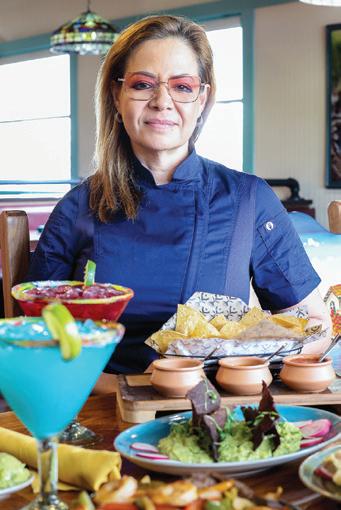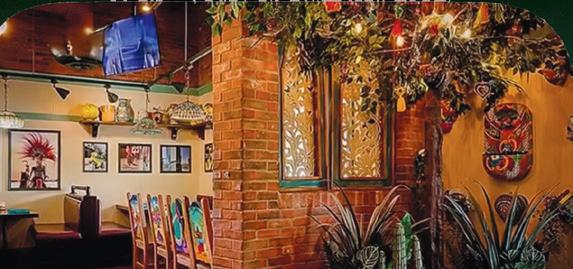NEWSPAPERS Special Edition

Warren Consolidated Schools Superintendent






Warren Consolidated Schools Superintendent




‘Hidden
BY MARIA ALLARD allard@candgnews.com
DETROIT — Retired Warren Consolidated Schools Superintendent Robert Livernois is a history buff, especially when it comes to Detroit landmarks and legends. He consistently researches historic buildings and interesting people that left their mark on the Motor City. He’s sharing his enthusiasm for history with others on a podcast called “Hidden in Plain Sight” available on various online sites, including Apple Podcasts, Simplecast and Facebook.
Livernois, who retired last year, keeps each episode about 6-10 minutes in length, and the podcasts are prerecorded and usually released on Tuesdays. He’s been all over the city to visit various sites that make Detroit unique.
Athletic figures, music icons, entrepreneurs, famous streets, artists, educators and more come alive when they’re “Hidden in Plain Sight.” Livernois was an English
See PODCAST on page 10A






‘Benefit on the Bay’ continues to help Capuchin Soup Kitchen
BY MARIA ALLARD allard@candgnews.com
HARRISON TOWNSHIP/ST. CLAIR
SHORES — When Michael Schodowski was studying tae kwon do to earn his black belt more than 40 years ago, another student invited him to visit the Capuchin Soup Kitchen in Detroit after class one night.
“I didn’t know anything about it,” Schodowski said. “He drove me there and gave me a tour. I was taken aback from all the good work they do. I felt more appreciative about the things we take for granted.”
After volunteering for several years, Schodowski — president of the company Shelving.com based in Madison Heights —














BY BRIAN WELLS bwells@candgnews.com
STERLING HEIGHTS — Several times a week, Jerry Boekhout and Art Siebert join a group of people who walk at the Sterling Heights Community Center.
The two had been walking together for about a year, but it wasn’t until recently, after a bit of back-and-forth conversation, they realized they shared a connection.
It started with them asking where they grew up — both responded that they lived on Fisher Street in Detroit. Eventually, they realized they grew up together in the same neighborhood and went to school together, Boekhout said.
“We just started talking out here, and then it just clicked,” he said. When they were in second grade — about 66 or 67 years ago, according to Boekhout — Siebert moved away and the men lost touch with each other. Boekhout went on to work for Warren-based Cold Heading Co., which makes fasteners for automotive products, and moved to Sterling Heights in 1974. He started walking at the community center about four years ago, he said.
“I’m retired but I keep exercising,” he said. “I’m a diabetic, and I like
See RECONNECT on page 7A




Anglers prepare for competition in Lake
the
BY SCOTT BENTLEY sbentley@candgnews.com
ST. CLAIR SHORES — Bassmaster Magazine released its annual list of the 100 Best Bass Lakes in America and Lake St. Clair was ranked in the top 10 in the country.
The magazine starts the rankings by compiling a top 25 in each region, and lakes located in Michigan are represented throughout the northeastern region’s top 25. Lake St. Clair and Lake Erie finished third and fourth, respectively; Burt/Mullett lakes and Grand Traverse Bay finished sixth and seventh, respectively; Lake Charlevoix and Bays de Noc were ranked ninth and 10th, respectively; and Saginaw Bay came in at No. 21 in the top 25.
After ranking each region, Bassmaster puts together the publication’s countrywide rankings and Lake St. Clair is always near the top. This year was no different. The local lake came in as the 10th best bass lake in America.
“(Lake St. Clair) has taken an average 25 pounds per day … to win a tournament on Lake St. Clair. So that’s a 5-pound average per bass,” Bassmaster Magazine Editorin-Chief James Hall said. “It’s not just smallmouth but largemouth playing as well. So, you have two separate and very desirable species. … What makes St. Clair special is you have a lot of fish, and you have big fish.”
Hall also pointed out that Lake St. Clair has been ranked as high as No. 1 in the nation in prior lists.
“When it was (ranked No. 1), the lines at the boat ramps were backed up 2 miles from where they launch the boat,” Hall explained. “It can create some more traffic; however, the
community gets so much benefit.”
There’s a lot that goes into the Bassmaster rankings and it’s always one of the most talked-about lists in the sporting world every year when it’s published. The top 100 isn’t just thrown together; it’s the culmination of a year of research.
“We start by sending out surveys to all of the DNRs of each state. … We ask each of them to rank the lakes in their state. They’re the ones that know best, and it’s based on catch rate, size of fish, access and stocking practices,” Hall said. “We also send out a survey to all of our BASS Nation conservation directors and presidents.”
Once there is a collection of lakes, then the real work starts for Bassmaster Magazine. The publication begins doing research and collecting data on the lakes and the fish in the lakes.
“We search for any possible tournament for any of the lakes that are mentioned… We see what, kind of, the high-water mark is for size of the fish. And then the cream kind of starts rising to the top,” Hall said. “The quality of results kind of start putting the lakes in order. … Then we start digging deeper and talking to pros, guides, fisheries, biologists. … Then we have a blue-ribbon panel, and we give them all the data.”
The process takes months to finish and is something that makes the consistently high ranking of Lake St. Clair even more impressive.
An angler who has found a lot of success at the lake over the years is Bassmaster pro Jay Przekurat. A Wisconsin native, Przekurat won the Bassmaster tournament at Lake St. Clair in 2024.
from page 1A
wanted to do more. So, in 1993, he invited family and friends to Island Cove Marina in Harrison Township for a fundraiser to benefit the nonprofit organization.
While listening to music from an AM/ FM radio, a crowd gathered for beer and pizza and raised $1,400 for the charity during Schodowski’s initial fundraiser. In its 10th year, the “Benefit on the Bay” fundraiser moved from the marina to MacRay Harbor, located at 30675 N. River Road in Harrison Township. Schodowski has never lost his desire to help the Capuchin Soup Kitchen and is preparing for the 32nd annual Benefit on the Bay Aug. 22 at MacRay Harbor.
“Benefit on the Bay is very high-electricity. There’s a high vibe in the room,” Schodowski said. “It’s a very high-energy event.”
The event will include food, entertainment, silent and live auctions, an ice cream and frozen espresso cart, and more. Doors open at 5:30 p.m. Also scheduled is a performance by the Capuchin Show Choir. Ryan Ermanni, of Fox 2 News, will emcee the benefit, and there will be a special appearance from retired Detroit Lion Herman Moore.
According to organizers, all of the evening proceeds support the Capuchin Soup Kitchen. To date, Benefit on the Bay has raised over $3 million in net proceeds for the charity.
“We underwrite 100% of the costs,” Schodowski said.
With its success over the years, Schodowski added another component to
from page 3A
“I’ve had a really good track record on St. Clair,” Przekurat said. “I think what makes the lake so good is the fish don’t sit on the same spots every year. … You can put the boat in the water, and you could float across the entire lake and catch a bass, which is the coolest part of the lake.”
The professional angler perspective on Lake St. Clair is similar to a casual fisherman, which is unique. It doesn’t matter what level you fish at. The lake is rewarding to all due to its features, or lack thereof.
“The lake is featureless. … It’s basically straight sand,” Przekurat said. “Those fish live out in the middle of the lake and there’s
the fundraiser: a VIP night. This year’s third annual VIP night will be held the evening before Benefit on the Bay from 6-9 p.m. Aug. 21 at Hook Restaurant, located at 24214 Jefferson Ave., in St. Clair Shores.
Tickets are $250 per person and include hors d’oeuvres prepared by Robert Nahra, also known as “Chef Bobby,” an open bar including Celani Wines and desserts by On the Rise Bakery Café, which is one of the Capuchin programs. Tickets are limited.
Those who attend will learn more about the Capuchins because several brothers from the charity will be in attendance. The VIP evening will have an island flair. Attire is casual, and guests can arrive by car or boat. Valet parking will be available. Sponsorships are available.
For tickets and sponsorship details for either event, go to benefitonthebay.org. Checks can be made payable to the Capuchin Soup Kitchen and mailed to Shelving.com c/o Mike Schodowski, 29275 Stephenson Hwy., Madison Heights, Michigan, 48071. For more information call (248) 318-7655 or email dbell@thecapuchins.org.
‘I believe we make an impact.’
Capuchin Soup Kitchen Executive Director Br. Gary Wegner said money raised during the annual benefit primarily is put towards the charity’s general operating expenses. Wegner, who has been a Capuchin friar since 1982, also said the organization does not receive any government assistance. He has attended the Benefit on the Bay events at MacRay Harbor for several years and described them as “celebratory.”
“It’s a beautiful location out on the lake,” he said. “People are very supportive. We hope they get to know the soup kitchen.
just not much rock. … I just think that’s the reason why it’s so good.”
Lake St. Clair is seen as a national treasure and the community will hopefully continue to benefit from what it provides anglers everywhere.
“It’s literally everything in that town,” Przekurat said. “Then to be able to showcase the body of water when the tournament does come around … it’s a huge event not only for the town, but for all the people that love to fish, or maybe they’re just getting into fishing and want to experience what Lake St. Clair is like.”
For more information about Lake St. Clair, go to michigan.gov or metroparks.com. To keep up to date with Bassmaster events, go to bassmaster.com or follow bass_nation on Instagram.
I believe we make an impact.”
Inspired by St. Francis of Assisi, a number of friars that were part of the Order of Friars Minor Capuchin, based in Rome, started the Capuchin Soup Kitchen in Detroit in 1883. In 1924, Rev. Solanus Casey arrived at the monastery, and the charity began to expand, especially when the Great Depression hit in 1929. The Capuchin Soup Kitchen now has seven programs to assist men, women and children in need.
The meal program, which started it all, currently has two Detroit sites for families to get a free meal. The 1264 Meldrum St. facility is open for breakfast and lunch. The second site at 4390 Conner St. offers breakfast, lunch and dinner. Wegner said between the two the meal sites more than 1,000 meals are served per day.
The friars also made farming part of its community with the Earthworks Urban Farm, a 1.25-acre certified organic farm located on the east side of Detroit. There is a spiritual care component, which serves as another program, and the Capuchin Services Center provides emergency food and clothing where items are offered in a retail-like setting.
The Capuchin Soup Kitchen also pro-

vides substance use disorder support and treatment and sponsors Jefferson House, a 12-bed, residential treatment facility for men recovering from addictions. The program, too, provides the men the opportunity to work at other Capuchin Soup Kitchen locations, for which they are paid a modest stipend. New residents to Jefferson House are admitted via referral from inpatient substance abuse treatment programs.
In an effort to boost the lives of children and teenagers, the Rosa Parks Children & Youth Program was incorporated with after school tutoring and art therapy sessions for children ages 6-15, youth leadership opportunities, and family activities.
The seventh Capuchin Soup Kitchen program is the On the Rise Bakery & Cafe located inside the Solanus Casey Center at 1780 Mount Elliott St., in Detroit. The bakery is open for business Tuesdays through Saturdays for muffins, pies, sandwiches, sweets, coffee and more. The menu items are prepared by men who have recently been released from prison or have completed a substance use disorder treatment program.
For more information on the Capuchin Soup Kitchen, go to cskdetroit.org or call (313) 579-2100.














• Over 1,000 Lamps and Fixtures in Stock
• Top Notch Customer Service
• In Home Consultations
• Full Service Electrical Supply House







YOU’RE INVITED TO SOME FOOD FOR THOUGHT
YOU’RE INVITED TO SOME FOOD FOR THOUGHT
Please join Michelle O’Hara, Advance Funeral Planner at Wm. Sullivan & Son Funeral Directors, for a thoughtful discussion about the many benefits of early planning. Lunch will be served.
Please join Michelle O’Hara, Advance Funeral Planner at Wm. Sullivan & Son Funeral Directors, for a thoughtful discussion about the many benefits of early planning. Lunch will be served.
Please join Michelle O’Hara, Advance Funeral Planner at Wm. Sullivan & Son Funeral Directors, for a thoughtful discussion about the many benefits of early planning. Lunch will be served.
Please join Michelle O’Hara, Advance Funeral Planner at Wm. Sullivan & Son Funeral Directors, for a thoughtful discussion about the many benefits of early planning. Lunch will be served.
WEDNESDAY, SEPTEMBER 10, 2025 | 12:00 P.M.
WEDNESDAY, SEPTEMBER 10, 2025 | 12:00 P.M.
WEDNESDAY, SEPTEMBER 10, 2025 | 12:00 P.M.
Filippa’s Italian Restaurant & Banquet 45125 Mound Road, Shelby Township, MI 48317






WEDNESDAY, SEPTEMBER 10, 2025 | 12:00 P.M.
Filippa’s Italian Restaurant & Banquet 45125 Mound Road, Shelby Township, MI 48317
Filippa’s Italian Restaurant & Banquet 45125 Mound Road, Shelby Township, MI 48317
Filippa’s Italian Restaurant & Banquet 45125 Mound Road, Shelby Township, MI 48317
Please RSVP to 586-731-2411 as seating is limited.
Please

Please RSVP to 586-731-2411 as seating is limited.
Please RSVP to 586-731-2411 as seating is limited.































(Within





























BY MARIA ALLARD allard@candgnews.com
METRO DETROIT — David Watson wanted to buy a classic car that represented the year of his birth: 1947.
The St. Clair Shores resident looked around but didn’t find one made that year. He got as close as he could, though, by purchasing a striking 1948 Chevrolet Fleetmaster Coupe. He bought the car in 2004.
While the white vintage vehicle — with the decorative purple and blue flames — is 77 years old, Watson had it modernized over the years at local shops.
“When I got it, it was all white. I had the flames painted on it,” he said. “I put the rims on it.”
If you look under the hood, you’ll see the motor of a 1991 Chevrolet Camaro IROC-Z.
“It’s just a modern engine. It’s fuel-injected,” Watson said. “It has a digital dash, power steering, power brakes, power windows, and a custom interior. It’s an automatic. All the shiny parts are stainless steel.”
Other updates were completed to keep the car running smoothly. The transmission was rebuilt, air conditioning was added, and there also is a power antenna and a power trunk. So he could play music, an AM/FM radio and a compact disc player were installed. And “breaker one nine,” the car has
See COUPE on page 7A

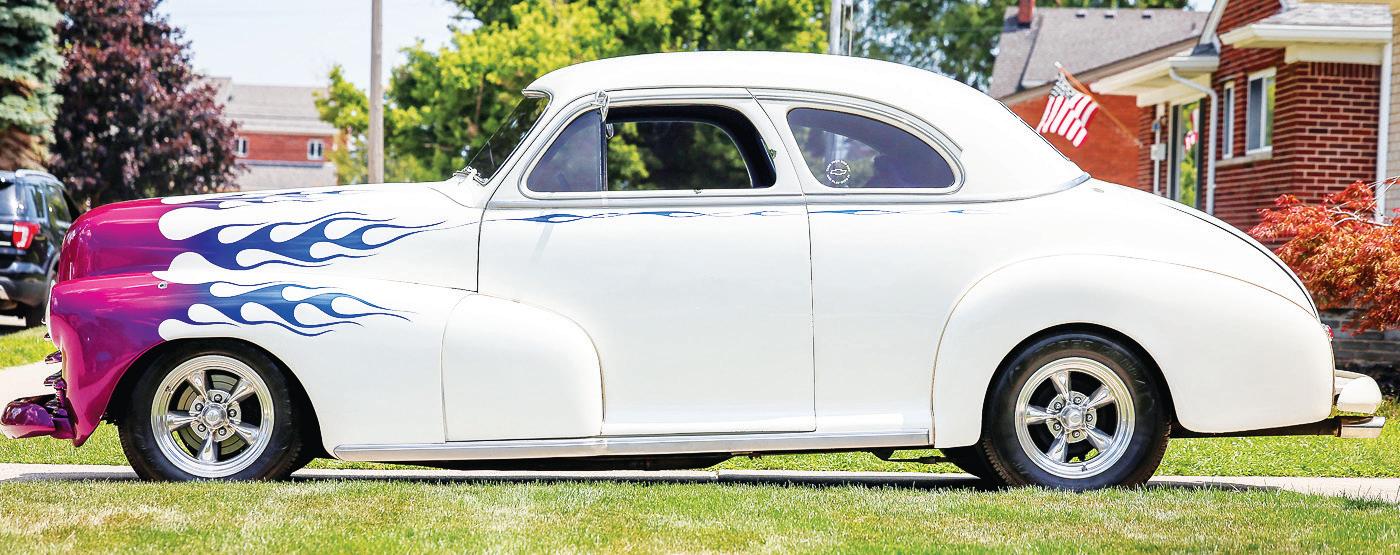
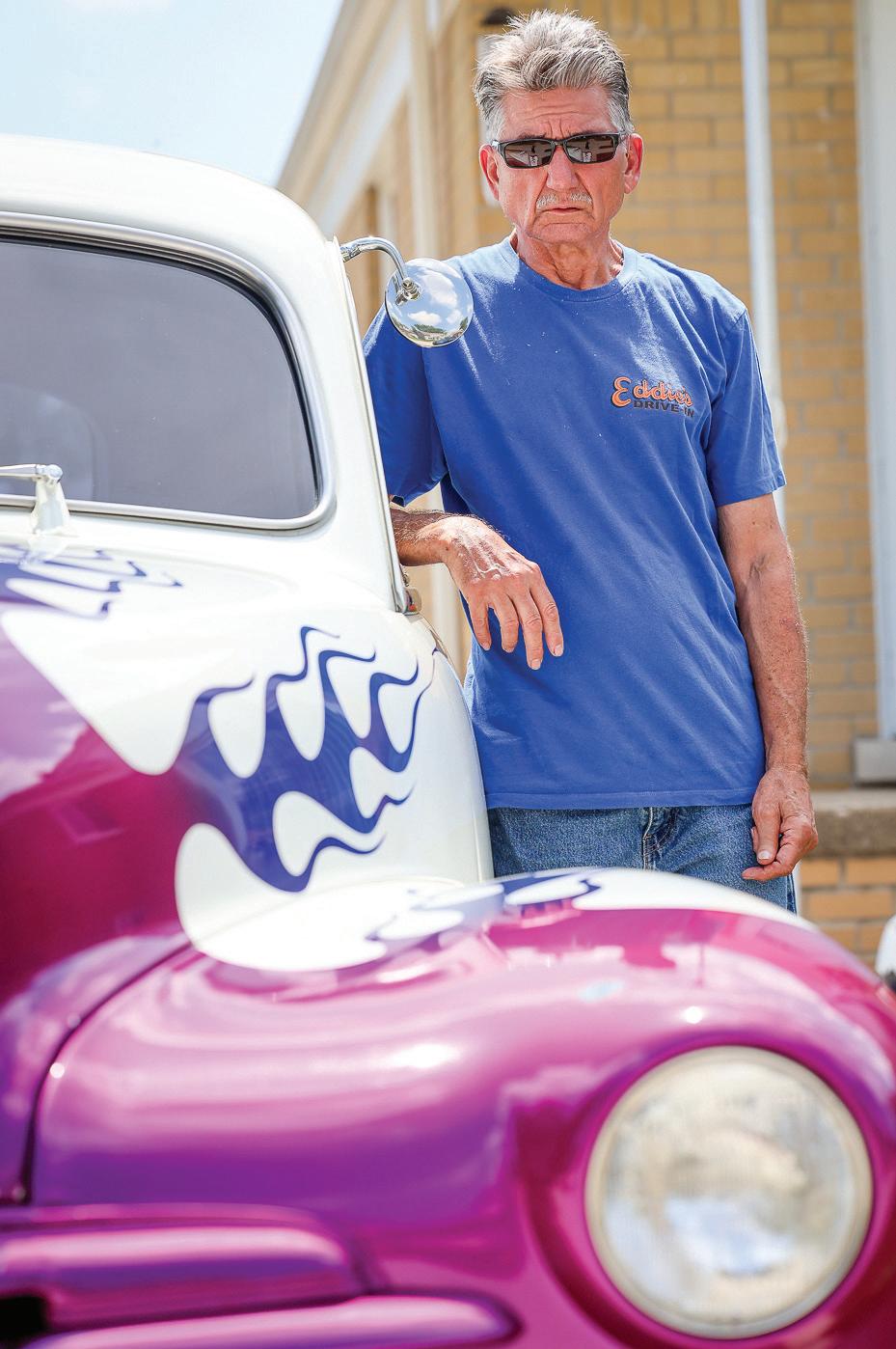









a citizens band radio that works, although Watson doesn’t use it.
The ’48 model does not have any door handles but rather shaved doors. The shaved doors were a popular trend that gave cars a smooth look.
Perhaps you’ve come across the car around town. One spot Watson likes to take the coupe on a regular basis to is Eddie’s Drive-In in Harrison Township, which has a classic car show from 4 to 8 p.m. every Sunday during the warmer months.
“That’s my favorite place to go,” Watson said.
Watson sometimes shows up to the weekly car shows from 5 to 8 p.m. Thursdays at St. Margaret’s Catholic Church in St. Clair Shores, and to the Friday night car shows from 5 to 8 p.m. at the Walter F. Bruce Veterans of Foreign Wars Post No. 1146, also in St Clair Shores. He made it to the Eastpointe Crusin’ Gratiot car show June 14 at Eastpointe High School.
“There’s somewhere to go every day,” the car buff said. “People wave and they give you a thumbs-up.”
He also comes across people whose dads or grandpas once owned a 1948 Chevrolet Fleetmaster Coupe, which generally sparks conversations. Watson’s car gets around, as it was featured in the background of a commentary video for the 2008 Clint Eastwood film “Gran Torino.” Watson used to go to Kalamazoo for the Street Rod Nationals, which he said was great for meeting other car enthusiasts.
“The newest car that could get in was a ’48,” Watson said. “Anywhere from 1925 up to ’48.”
Watson has always been into cars.
from page 3A
to exercise, and it keeps my sugar numbers down.”
Siebert went on to work for and eventually retired from Bud Wheel, a stamping plant in Detroit, where he was a press operator.
Siebert moved to Sterling Heights in 1989, but only started walking at the community center about a year ago to keep himself healthy.
While he isn’t aware of any other longlost friends reuniting, Parks and Recreation Director Kyle Langlois said the Sterling Heights Community Center is meant to be a
“When I was 15 years old, I started working on cars. I would go to people’s houses. The first car I ever worked on was a 1953 Buick convertible. A straight-A car, three speeds on the column,” he said. “My neighbor gave it to me. He said, ‘Here, it doesn’t run. You can have it.’ At that time, there was nowhere to donate them. You just took it to the junkyard. This was in ’62.”
Watson found a Buick book and discovered it was the coil causing problems for the convertible.
“I put a coil on it and I gave it back to him,” said Watson, who found a new pastime fixing cars in the neighborhood. “I got really busy. I couldn’t do it anymore. Too many cars at the house.”
At age 21, while working for Chrysler, Watson bought his first car, a 1969 Plymouth Road Runner. Price tag: $2,850.
“It was a ’69, but I bought it in December of ’68. We were making, I think, $3.40 an hour,” Watson said. “The car payment was $100 a month, but I paid $1,000 a year for insurance in 1969, which was a lot of money then; it’s a lot of money now. The first year, I put 30,000 miles on that car. I just went everywhere. My mother would pull her hair out because at the time there were no cellphones and no way to track you.”
As a young adult, Watson cruised Woodward Avenue. Maverick’s Drive-In, Big Boy and the Totem Pole on Woodward were regular hangouts.
“You would go and mingle,” he said. “You could cruise then and people would pull over and stop. You could talk to them.”
The Road Runner was like a second home.
“I slept in the car out on Woodward more than I slept in my house. You get tired, too far to drive,” Watson said. “I had police wake me up, ‘Hey, what are you doing?’ I’m in the back sleeping.”
place for people to gather and connect with one another.
“What’s great about everything we do is, you set your differences aside. You find your commonalities,” Langlois said. “It doesn’t matter what your background is. Everybody’s coming together for a common purpose, whether it’s to walk, whether it’s to come to a concert in the park or participate in some other activity or program. The commonality is whatever you’re coming for.”
Since their reunion, Siebert and Boekhout have continued to walk together and have gone to breakfast several times, they said.
“I think it’s great. I think it’s fantastic,” Siebert said.


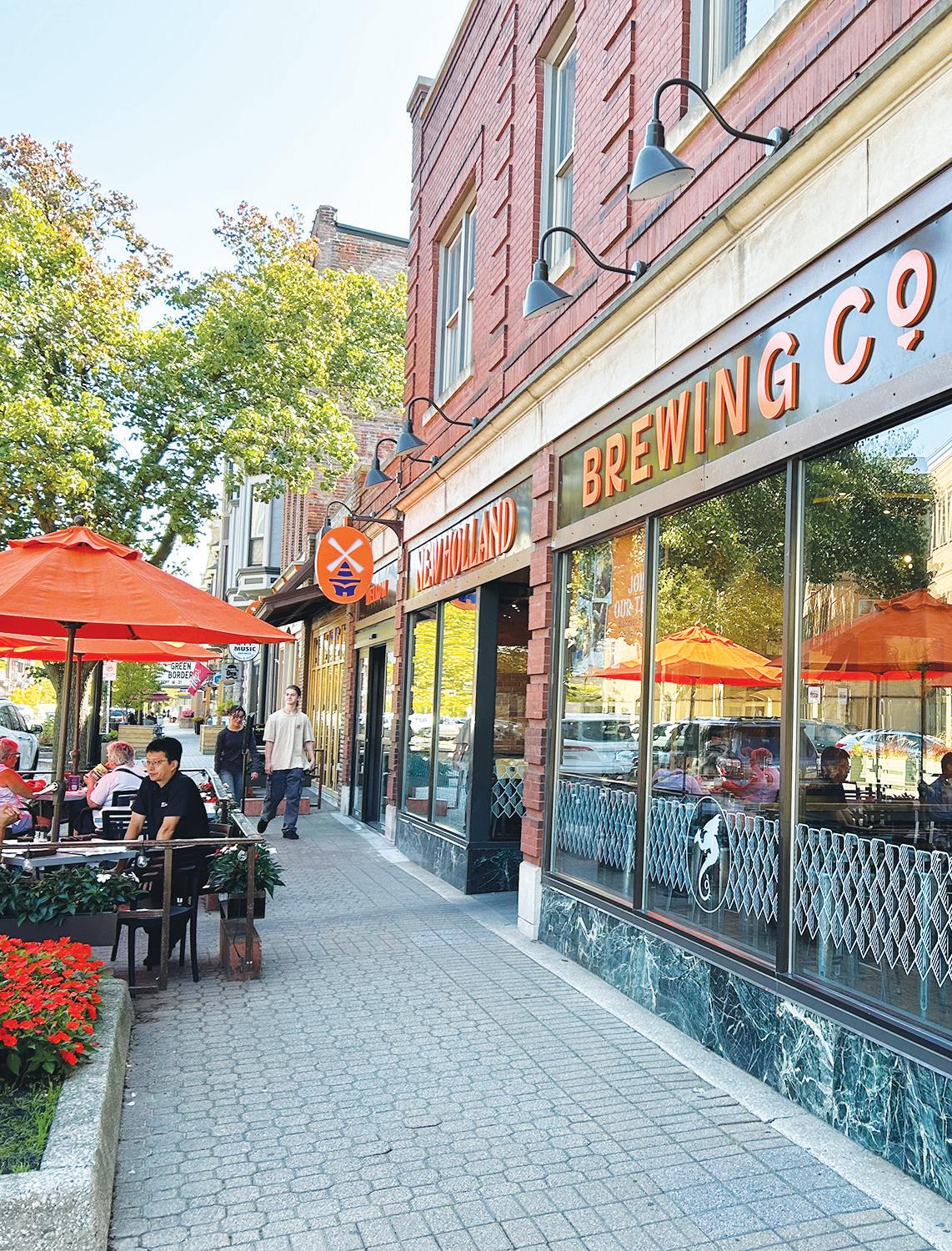


BY GREG TASKER
HOLLAND, MI — There’s no shortage of sandy shores or charming beach towns along the Lake Michigan coastline.
Ask any avid Michigan beach goer to share their favorite sunbathing spot or lakeside town and they’ll likely have a favorite or two.
Lately, I’ve been touting the delights of Holland, a spiffy, handsome community more famous for its colorful tulips and Dutch heritage than its beaches and resort amenities. At least that’s what I thought.
Imagine my surprise late last summer when I ventured beyond the Lake Michigan beaches to explore downtown Holland and discovered much more than a beach town. Holland’s tree- and flower-lined streets are home to upscale shops, al fresco dining, public art and much more.
Holland’s vibe may be a bit more sophisticated than that of other beach communities along Lake Michigan, but it’s no less welcoming.

You could spend long afternoons apres-beach browsing Holland’s nine-block downtown, where you’ll find everything from men’s and women’s clothing to home accents and gifts to Dutch souvenirs. Beach towels and chairs, and T-shirts — staples of any beach town — are less prominent here.
Maybe that’s because Holland’s beaches are a short drive away. The city doesn’t sit on the shores of Lake Michigan but on the shores of Lake Macatawa. Neighborhoods border the 1,700-acre inland lake, which connects to the great lake by a channel.
Downtown Holland impressed me for many reasons: the mix of architecture styles from the late 19th and early 20th century, including examples of Italianate, Late Victorian and Renaissance Revival; a vibrant, walkable downtown and the one-of-a-kind retailers who add to the sense of being somewhere beyond Michigan.
This is not a beach town that rolls up the sidewalks in the off season. In the winter, an underground heating













Once I get the right diagnosis for the cause of your heel pain, I will provide you with a tailored treatment plan, which outlines exactly how we can fix your heel pain and keep you free from future foot pain. If you are ready, call me for an appointment to start your journey back to normal life, free from heel pain.



system — known as Snowmelt — melts the snow and ice on downtown streets and sidewalks. It’s the largest municipally run snowmelt system in North America.
Downtown shopping
Stores like the Holland Clock Company and Nelis’ Dutch Village add European charm. The Holland Clock Company sells handcrafted German clocks, beer steins, nutcrackers, and ornaments. Nelis’ Dutch Village offers a huge selection of Dutch gifts, Delftware, souvenirs, imported foods and snacks, and, yes, wooden shoes. You can also sample some 20 Dutch cheeses and have your wooden shoes personalized. The aisles at Out of the Box are lined with toys, puzzles, board games and more.
There are, of course, familiar resort town shops, peddling iconic Michigan summer staples. They include Cherry Republic for all things cherry, and Kilwins for chocolate, fudge and ice cream. They share the streets with locally based food purveyors like Crane’s in the City, wellknown regionally for its various fruit pies. The family-owned shop on Eigth Street also
sells sandwiches, salads and other desserts. The Holland Peanut Store, run by the same family — the Fabianos — for more than a century, is a sweet treat for all ages, selling homemade chocolates, fresh roasted nuts and nostalgic candy.
Holland’s restaurant scene is diverse, with many eateries offering alfresco dining along the city’s main downtown thoroughfare. You’ll find everything from traditional American and pub fare to deep dish Chicago pizza to Asian and Mexican offerings.
I especially enjoyed the tapas at Poquito. The star of the meal was the 36-hour braised beef short ribs served with crispy brussels sprouts; tangy Rioja jus enhanced the flavor of beef so tender it fell apart.
One lazy afternoon, I popped into New Holland Brewing Co., a downtown staple, to check out the beer selection. Full Circle, a Kolsch-style ale, one the craft brewer’s legacy brands, quenched my thirst after a long day on the beach.
No visit here would not be complete without sampling Dutch-influenced fare. For traditional tastes, try a klompen cake (a buttermilk pancake-like treat) or saucijzenbroodjes (Dutch sausage rolls) at the two locations of deBoer’s Bakkerij (bakery).

Breakfast was so filling, I never made it back to sample other “Dutch Stuff” on the lunch menu. “A Taste of the Old Country,” a combination of a croquette, a pig in a blanket, a cup of pea soup and a slice of Dutch mild gouda cheese — sounded tempting.
In the spring, Holland transforms into a floral paradise, as more than 5 million tulips bloom in the gardens and parks, celebrating its Dutch heritage. One of the best venues to enjoy the tulips is Windmill Island Gardens. By summertime, of course, the tulips are long gone but the gardens remain well worth a visit. The gardens are replanted with annuals after tulip time. You’ll see dozens of varieties in themed beds. The well-manicured gardens are also home to Tour De Zwaan, the only authentic Dutch windmill operating in the country. The windmill still turns and grinds wheat into flour. From the top of the five-story windmill, you can take in views of the 36-acre park.
Stop at De Klomp Wooden Shoe & Delft Factory to buy a pair of traditional wooden shoes or Delftware pottery with its distinctive blue designs.
And then there’s the beaches, which
drew me to Holland in the first place. The primary beaches are Holland State Park and Tunnel Park, both on Lake Michigan and a short drive from downtown. There are other beaches, of course, but either of these is a solid choice for a summer day of sunshine, sand and water activities.
Tunnel Park is located north of the state park and is named after a tunnel that cuts through a dune to reach the expansive, sandy shoreline. The park also has a playground, a dune climb and a dune stairway that leads to scenic views of Lake Michigan.
The 142-acre Holland State Park boasts beaches on both Lake Michigan and Lake Macatawa. Kayak, canoe, and standup paddleboard rentals are available at the Macatawa Boathouse. At the park pavilion, Beachplace Cafe and Shop rents chairs, umbrellas, beach wagons and volleyballs. The cafe serves standard beach fare — burgers, fries and more, and the gift shop stocks sunscreens, inflatable beach toys, snorkels and masks.
Downtown Holland may create the sense of being worlds away, but the beaches — especially Holland State Park with its views of the iconic Red Lighthouse — will remind you of exactly where you are.
Greg Tasker is a Traverse City-based freelance writer.

teacher at South Lake High School in St. Clair Shores before becoming an administrator in Warren Woods Public Schools and Warren Consolidated Schools. History always piqued his interest.
“The amount of history in Detroit is staggering given how many different periods it went through. The city is being rebuilt from the inside out,” the 1984 South Lake High School graduate said. “That’s the whole spirit of ‘Hidden in Plain Sight.’ All of my episodes have a nice twist to them.”
Livernois, of Troy, takes listeners back to the 1700s, 1800s and 1900s. As the city rebuilds, Livernois said that many of the new buildings going up in Motown feature pieces of the past. He shares such tidbits on the podcast.
“A corner of the Motor City Casino is the original Wonder Bread baking plant. Like where Ford Field is, they’ve preserved some of the Hudson (department store) warehouse,” Livernois said. “That’s the kind of connection I am trying to sew together. The more people I talk to the more I realize how much people want to share what they know about history.”
When learning more about Faygo, his listeners chose Rock & Rye as their favorite flavor with Red Pop as a close second.
The educator, who has been an adjunct professor at Wayne State University, always wondered about Livernois Avenue, his surname. When conducting research on the road
that travels through Wayne and Oakland counties, Livernois discovered he is a 12th generation descendant of early Detroit settler Paul Benoît dit Livernois.
On another podcast, “Detroit’s Forgotten Founder: The Man Behind the Motto,” Livernois pays tribute to the Rev. Gabriel Richard, who did everything from serving the Lord as a Catholic priest to helping establish the University of Michigan, to coining Detroit’s motto, “We hope for better things; it will rise from the ashes” after the city’s Great Fire of 1805.
Childhood friend Tom Rempel became a fan of Livernois’ podcasts.
“I think he’s done a fantastic job. He’s really into history big time,” said Rempel, who resides in St Clair Shores. “He does a lot of research, too. My parents used to take us to these places.”
One podcast that drew in Rempel was the piece on the Grande Ballroom titled “The Ballroom That Rocked Detroit,” which first aired June 3, 2025. Rock ‘n’ roll fanatics who grew up listening to Led Zeppelin, The Who and the MC5 know all about the rock club once located at 8952 Grand River Ave.
“That was really cool. I’ve got older brothers, and they grew up with those bands, Cream, Jimi Hendrix,” Rempel said.
Those who follow sports can reminisce in the episode “Home Runs and Hardware: The Brooks Lumber Story.” In it, Livernois talks about the Brooks Lumber business; Tiger Stadium once stood next to it in Corktown. You could hear the baseball bats cracking when Babe Ruth, Harmon Kil-
lebrew, Reggie Jackson, Ted Williams, Norm Cash and Kirk Gibson all hit home runs that flew out of the stadium and landed on the property of Brooks Lumber. Rempel was at the game in 1962 when Killebrew, who at the time played for the Minnesota Twins before becoming a Tiger, smacked a home run over the roof at Tiger Stadium.
“I was like 5 years old. My mom said he hit it over the roof,” Rempel recalled.
Livernois can picture the people of the past who once ventured to the places he researches. He can envision the crowds at Red Wings hockey games and get an idea of Detroiters heading out for a night on the town. One of his favorite Detroit spots is the Masonic Temple, located at 500 Temple St. According to him, there’s a roller derby rink in the building, ballrooms and more.
“I’ve been there many times for a concert. If there’s a place in Detroit that’s hidden right in front of you it is the Masonic Temple. You’re walking by a building that has over 1,000 rooms in it,” Livernois said. “Once a year they would have a flea market in the roller derby rink. When you’re in that space you can see the floor and all the scuff marks from the roller skates where they race around.”
The Alger Theatre, located at 16451 E. Warren Ave., in Detroit, will be featured in a future broadcast. The Alger opened in 1935 and is 90 years old. According to the website algertheater.org, it opened its doors to a full house, playing a double feature of “The Girl from 10th Avenue” starring Bette Davis and Ian Hunter, and “Oil for the Lamps of China” starring Pat O’Brien, Gene Muir, and Josephine Hutchinson.












































































































